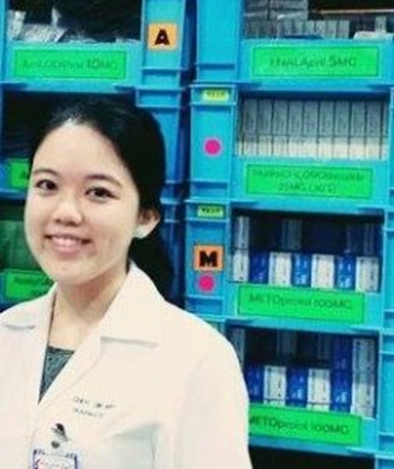There’s much more to an outpatient pharmacist’s job scope than over-the-counter duties, as I found out from a friend who is now based at a Klinik Kesihatan (KK) or Government Health Clinic (GHC) in the Malaysian state of Johor Bahru. In fact, she was excited to share with me her experience, and this, in turn, helped me broaden my understanding – especially when my background is in the humanities.

Chew Sin Nah (pictured) has been with the clinic, ranked one of the most visited amongst 14 branches within the Johor Bahru district, for nearly four years. Chew is currently overseeing the Diabetes Medication Therapy Adherence Clinic (DMTAC) in the KK.
What made you want to be a pharmacist?
From a very young age, my late father had always taught me to be kind and helpful to those in need. I guess that instilled the sense of helping as many people around me.
Until today, I continue to be active in the Red Crescent Society, which I had joined in primary school when I was in Standard 3. I started learning first aid at primary school level and I later became a first aid trainer at secondary school level. In fact, I’m now working in a clinic that has a Red Crescent logo.
There is job satisfaction that comes from helping patients regain their health. Knowing that just by doing my job well, chances are higher that patients would experience improvement both physically and mentally. In addition, the GHC is one of the avenues where first point of contact occurs. It is only in the primary healthcare setting that we have the chance to propagate the importance of preventive healthcare to the public.
Describe a typical day at the KK.
Besides dispensing medication (to patients who have registered and gotten their numbers before waiting in queue), we also provide counselling for patients who are new to medical devices like insulin pen, metered-dose inhaler, and accuhaler. For these cases which require a longer duration of counselling, patients would be directed to our available counselling rooms. Otherwise, counselling would be done over the counter.
What are some of the main services at the KK? How do they compare to a private clinic?
There are many services offered such as Medication Therapy Adherence Clinic (MTAC) for Diabetes, Retrovirus Disease, and Respiratory Disease. Under our harm minimisation clinic services, there are the drug addiction and smoking cessation programmes. We used to have the home medication review programme for patients who are bed-ridden and without caregivers/caretakers. Now, we have adjusted the programme to cover only medicine supply. Furthermore, we also have mother and child health clinic (MCH) and psychiatric clinic.
A GHC can definitely offer more healthcare services to the public with more manpower to facilitate the programmes.
Can you help clarify whether all KKs nationwide have a standard operating procedure (SOP) to follow?
Yes, we need to follow the SOP that’s put in place to ensure that tasks can be carried out smoothly, and patients receive a standardised service.
What about peak hours/seasons? How do you cope with it?
Usually a few days before and after the festive season, the patient loads would increase. Peak hours at the clinic are from 9.30am to 12pm and 2.30pm to 4pm. During peak hours, we would allocate more staff to be stationed at the dispensing counter to ease patient load. Given the size of our (existing) waiting area in our clinic, we decided to reduce the crowd by opening another dispensing area named Pharmacy B, for acute illness medications such as viral fever, soft tissue injury, and pre-natal anaemia.
Talk to me about the times you had to be on-call.
Hahaha. In simple terms, it is ‘overtime’. On-call, that usually happens once or twice a month. There are two types of on-call, active call and passive call. Active call means we need to be physically present for a certain time-frame, whereas passive call works on a case-by-case basis.
Where are your medicinal supplies/supplements from? What types of drugs are they? Are they generic, branded, or a mix of both?
Medication supplies are from the central store, managed by pharmacy staff from procurement service. We have many drugs in our store ranging from chronic illness medications such as for high blood pressure, diabetes, high blood cholesterol, psychiatric disorders and hypothyroidism. The medications come in both generic and branded to cater to different needs of our wide range of patients.
What are some of the common ailments or conditions from your experience at the clinic?
They include: Diabetes, Hypertension, Dyslipidemia, Hypothyroidism, Hyperthyroidism, Depression, Schizophrenia, Bipolar Disorder, Anaemia, Bacterial Infections, Scabies, Tuberculosis and Pneumonia.
What is the average waiting time, as far as the outpatient pharmacy department is concerned?
Less than 30 minutes, that is our Key Performance Indicator (KPI).
Who do you work with?
We work with doctors, medical assistants, nurses, physiotherapists, occupational therapists, dieticians, and lab technicians.
How about collaboration(s) with other government agencies/hospitals/private hospitals/clinics for certain campaigns and programmes? Would you be able to name a few?
Yes, we collaborate with the National Diabetes Society and certain pharmaceutical companies for World Diabetes Day.
What sort of patients do you get? Are there those from outside Malaysia? Do you think patients are more educated or misinformed now, especially with the presence of the Internet and mobile applications (apps)?
We have many patients from across the world as well. For example, there are UN refugees, about 10 of them, and foreign labour from Pakistan, Nepal and Cambodia. These groups of foreign labour are usually accompanied by their supervisor. There are also foreigners who have intermarried with the local Malaysians. (For instance, Malaysian-Chinese with Vietnamese, or Indonesian-Malay with Malaysian-Malay). Once in a while, as my colleagues and I are comfortable speaking in both Malay and Chinese, it can be tricky communicating with foreigners who don’t know either one of these languages. Our patients are from all walks of life, some highly-educated, others illiterate. I can see that some may be misinformed in the sense that they think they would be able to self-remedy.
How do you ensure that patients get an adequate and accurate prescription?
From the aspect of dispensing medication, we go through a triple-check system – from screening to filling, labelling, and then dispensing. Pharmacy staff from each station will do a double-checking for the accuracy and adequacy of prescription. Of course, we would address poly-pharmacy issues, food-drug interactions or contraindications of the regime and discuss with doctors for the best treatment outcome.
How do you go about explaining the side effects of medication?
We would let the patients know that most medications come with side effects if they are not used appropriately. We always use the medications only when the benefits outweigh the risks. We would point out the common side effects of certain medications so that if patients were to experience any of the side effects, they can identify and easily refer to us.
How much does it cost for outpatients (both Malaysians and non-Malaysians)?
Currently, across all KKs, for doctor’s consultation fees: RM 1 for Malaysians; RM 40 for foreigners. Medications are free. However, we also limit medications to foreigners and tell them to get them from private clinics or retail pharmacies instead. Anyhow, it also depends on whether these foreigners come for consultation, as most of them seek to be treated for short-term illnesses like colds.
What can you say about the confidence level of the public in these KKs? Has it improved over the years, you think?
As the quality of the pharmacy staff improved through more training, the standard of our service increased. Additionally, news spread fast, hence there is an increase of nearly double the numbers over the past two years.
So far, what are the challenges that you’ve experienced? What about something funny or sweet?
I have learnt a great deal during the course of my service. Aside from improving on medication knowledge, I have witnessed humanity, kinship, and living a principled life. As I am in charge of the DMTAC, I would see patients personally to help them address their concerns and allow them to learn self-management of blood glucose levels. There used to be this elderly couple who’d always come together, the male patient had stroke – four times. He also has unstable gait and slurred speech. His wife would always help him with all the medications and dietary and lifestyle modifications, even though the patient can be stubborn at times. There was once, his wife scolded him for drinking coffee, then he brought a huge plastic bag filled with one teaspoon of coffee powder to the clinic, just to show me that he didn’t drink a lot. Hahaha.
I always get emotional whenever I see patients come in with their caretakers as some come in alone. Those moments make me reflect on life. Those who come in for consultation and advice lose their health, and all these happened due to a lack of knowledge in healthcare, especially preventive healthcare.
Challenges, ah yes, it takes a lot of patience to deal with psychiatric patients. Hahaha. But well, we are now quite used to communicating with them effectively.
Anything else you’d like to add about your experience?
Many people overlook the importance of primary healthcare centres like the KKs and tend to favour tertiary healthcare centres like hospitals. In fact, primary healthcare is of utmost importance as it is the first point of contact for patients. Physicians (at the KKs) need to be able to identify red flag symptoms from patients and improve on their referrals to the specialist departments in hospitals. Primary healthcare front-liners should think of themselves of ambassadors of good health.
Notes/Definitions: –
Insulin pen: Used by those who have diabetes to inject insulin
Accuhaler: There are various medications in this type of inhaler, used by those who have asthma and chronic obstructive pulmonary disease (COPD). An example of a dry powder inhaler.
Metered-dose inhaler: Propellant-spray type inhaler, which offers the patient more time to inhale the drug.
Diabetes: When one’s blood sugar level is higher than acceptable.
Hypertension: The medical term for high blood pressure when one’s blood pressure is higher than the normal 120/80.
Dyslipidemia: When one has high blood cholesterol levels.
Hypothyroidism: Characterised by an underactive thyroid gland.
Hyperthyroidism: Characterised by an overactive thyroid gland.
Depression: One might be diagnosed with depression if symptoms such as helplessness, guilt, anxiety, fatigue, and loss of interest in hobbies, persist for a minimum of two weeks. However, no two persons will have the exact same symptoms.
Schizophrenia: Someone might be schizophrenic if s/he hallucinates and hears voices (that are non-existent), which in turn, leads him/her to do something. A person who has schizophrenia might share similar signs and symptoms with those who have bipolar disorder.
Bipolar Disorder: Characterised by someone having two extreme moods, manic and depressive, say, within a day. While s/he is at his/her manic episode, s/he thinks s/he can achieve anything, even those considered impossible to a mentally sound person.
Anaemia: Diagnosed when someone has a low number or quality of red blood cells needed to transport oxygen around one’s body.
Scabies: When one’s skin is infested by a particular mite, one has scabies.
Tuberculosis: A contagious disease, typically affecting lung function first, caused by a certain type of bacteria.
Pneumonia: Usually arises from an upper respiratory infection.
UN: To denote the United Nations, an inter-governmental organisation that works to tackle global issues. The UN has nearly 200 member states and consists of smaller agencies and organisations that have their own functions. In this context, the agency responsible is the United Nations High Commissioner for Refugees (UNHCR) to provide refugees with basic needs.
Retrovirus disease: AIDS is one example of a retrovirus disease caused by the human immunodeficiency virus (HIV).
Soft tissue injury – A type of injury that includes injury to muscles, tendons and ligaments. Tendons are bands that connect muscles to bones. Ligaments connect bone to bone. Injury occurs when there is damage or overstretching.
Pre-natal anaemia: Iron deficiency during pregnancy, which without early intervention, can cause low birth weight, premature delivery and maternal death.










Showing 0 comments